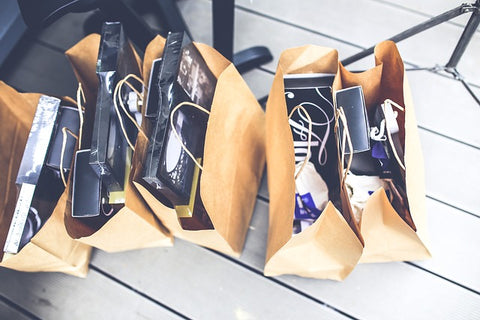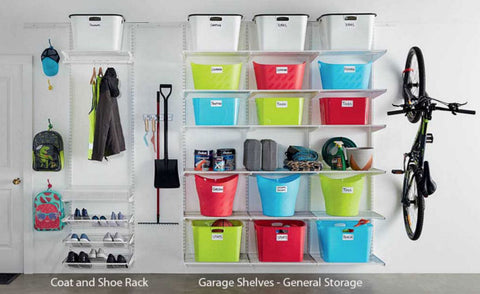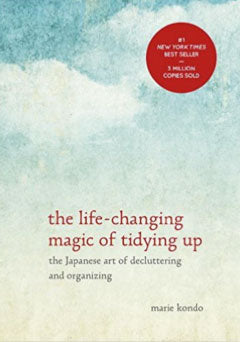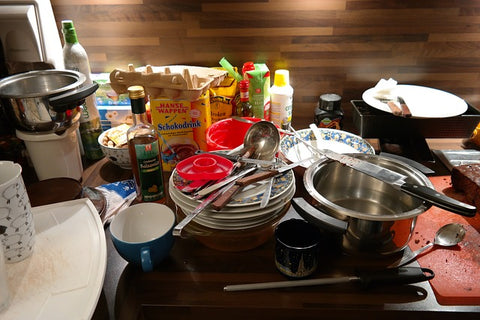⭐⭐⭐⭐⭐ 2000+ Customer Reviews
Need Help? Contact Us
info@shinemirrors.com.au
📞1300 797 708
When the house is cluttered, it can affect all aspects of your life, from your mood to your stress levels. The more cluttered it becomes, the bigger the task ends up! Not only this, but a cluttered home can also be dangerous, especially if you have small children running around. It doesn’t take long for a huge mess to accumulate in the home. We are probably all guilty of buying things and never using them, but instead of throwing them out or taking them back to the shop, we just stick them at the back of the wardrobe. If you want to create a stress free environment, these tips for decluttering your home and becoming more organised should help.
1. Work Out a PlanThe first step of the decluttering process is to work out a plan of what you are going to do, when and how long it will realistically take. The declutter process can take months, depending on the size of your home and no one wants to spend a constant five hours cleaning up. It will only make you feel fed up and you will probably just end up throwing all the clutter back in its original spot!

You should create a manageable diary for your declutter. For instance, you might want to start off spending an hour on a bedroom, then the next day in the attic and so on. This will make it more manageable and much less like a massive uphill struggle.
2. Be Decisive
There is no point in starting your de-cluttering only to find that you haven’t actually thrown anything out at the end of it, as it will just be a waste of your time. Make sure you are fully committed to throwing items out that you no longer need and that your family also agrees on what you can and can’t get rid of. It’s not always easy to remove items from your life, especially if you have had them for some time, but it is an important part of the declutter process.
As according to professional organiser Decluttering Diva Kristina Duke, ask yourself if you use it. If you haven’t used the item in the last 12 months or so you probably don’t need it. With regards to decluttering decorative or seasonal items she would ask her clients what memory or feeling does this object emote, as we so often hold onto things that we can’t even remember who gave it to us or where we got it. It has just become clutter that distracts us from seeing the things we love.
3. Clean as You GoIt is important to try and clean as you go along, as you don’t really want to completely declutter and organise and then go through the entire process again for the purpose of cleaning. It is a good idea to take each room first, declutter, clean and then move onto the next. You are more likely to make a great job of it if you spend some concentrated time on each area, rather than jumping around the different rooms. Having one room organised and clean gives a sense of achievement and an inspiration to declutter onto the next rooms.

The less clutter, the easier it is to clean up. A great way to practice this is doing the "1 bag in, 1 bag out" technique. The number of items you bought, will need you to have the same number of items you have at home to give away. This will be very helpful especially when you want your wardrobe stay controlled. Better still, go a notch higher and challenge yourself by giving away two or three items when you purchase one new item.
4. Invest in Storage
A good way of de-cluttering is to invest in some storage, such as drawers and boxes. This means that instead of having bags of toys, clothes and handbags in the wardrobe, you can organise them nicely so that they are easier to access. There are lots of options for storage these days and you can even brighten up the room with some nicely coloured and patterned choices.

At Howards Storage World, they share how to avoid clutter in the garage by using colourful tubs.
Here is one way of organising the closet as it suggests to label the shelves and storage containers to easily find where things are.
Have a rule wherein if the items does not fit in the storage box, it does not go in. Use storage boxes that have lids to control the number of items, and also to keep them clean and free from dust.
5. Recycle Old Items
If you truly want to declutter, you will need to get rid of anything that you don’t use anymore or don’t want. One man’s trash is another man’s treasure, as they say and you may find that items you don’t use are really appreciated by someone else. A full declutter is also useful for finding things that you do want, but have just forgotten about. You never know, that jacket you thought you lost, may be lurking under a box somewhere in your wardrobe.
Even simple things around the house, like the binder clip, can have plenty of other uses that helps in decluttering the space, such as organising computer wires, and headphones, acting as covering for shavers, and many more, as shown here.
There are many other options for recycling old items, including giving them to a charity, organising a garage sale or selling them online. Another way is to donate to relatives as hand me downs. At times it is easier to let go of precious things knowing it will be put to good use by someone we know.
6. Organise Drawers
If you find that you are unable to find what you are looking for in your drawers, it might be time to look at organising these. If you neatly fold your items and organise them into different drawers, it will make life a lot easier. For example, splitting different clothes into separate drawers will make the morning a lot less stressful and the home a lot tidier. Bestselling author Marie Kondo also recommends organising clothes by colour and stacking things vertically to easily see them.

"Once you've decluttered, you can use boundaries or rules to keep it that way. You can create rules around putting things in their homes, and rules around acquiring new belongings so that you don't get out of control again. By having boundaries around your volume of possessions, you can then select only what fits within that boundary and the rest can go." as advised by Clear Space professional organiser Rebecca Mezzino.
7. Use Mirrors to Widen the Space
If you want to make the rooms in the home appear more spacious and make the best use of the space, there are some clever tricks you can try. Firstly, a well-lit room will create the illusion of a bigger space, so it is worth investing in some new lights. Mirrors are also a good way to make a space appear bigger, so if you don’t have mirrors in your home, it is time to start looking. Mirrored Furnitures not only gives the additional storage, but also adds another dimension thus making the area look spacious. Check them out at Shine Mirrors Australia.
8. Be Creative
It may be that you can use your creativity to make the most of your declutter. For example, you might have old baby clothes that you could combine together to make a blanket, or you might want to upcycle some furniture and use it outside. There are lots of options to let your creativity run wild and you never know, you might find ways to make some extra money in the process. The more fun you can incorporate into your declutter process, the less pain staking it will become. Etsy seller Sonia Singh from Hobart, Tasmania who won the Etsy Community Choice Award 2015 uses discarded fashion dolls and recreates them giving a whole new fresh, down-to-earth look. Her Tree Change Dolls also inspired people all over the world to aspire and celebrate who they are in their natural wonder.
9. Throw a Party
If the thought of organising your home on your own is a bridge too far, why not throw a party and get friends to help out. Ok, it might not be the kind of party they would expect, but throw in some wine and the promise of some new clothes and they will probably be only too willing to lend a hand.
10. Maintaining the Organised State

Professional organiser Lisanne Oliver from Sorted! agreed that maintenance can be tricky. Like learning a language, or cleaning the house, you can't do it once. The most important thing is to schedule time for maintenance. A good example is do a "Monday Money". On Mondays, attend to all finances, paying bills, checking bank balances, data entry etc. Daily maintenance might be emptying the dishwasher, cleaning the pet bowls, or putting away clean clothes. Doing small things everyday would lessen the decluttering time.
11. Rewards
It may seem like a silly idea but you can never underestimate the motivation you can suddenly muster up, if you know there is a treat waiting for you at the other end. For example, when you complete one room you might decide to enjoy a long soak in the bath with your favourite magazine or you might want to treat yourself to a bar of chocolate after your hard graft. If you are selling some of your clutter, you may want to consider using the money to treat the family on a holiday.
Here is a sample of doing decluttering in action in the toys room. Little Miss Organised professional organiser Bonnie Black shares her technique on how to organise toys in just 5 steps: